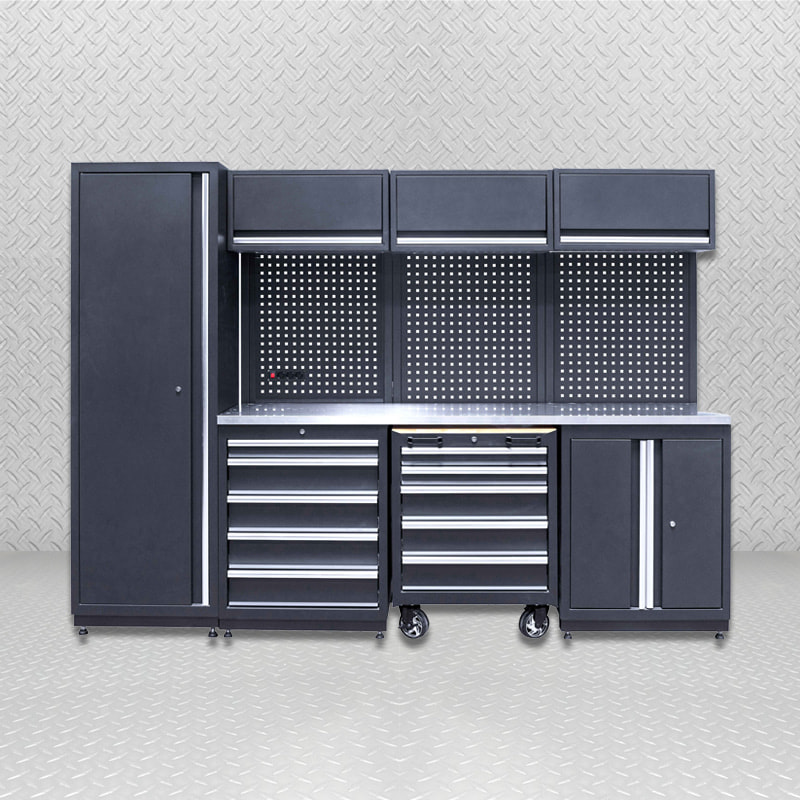Both powder coating and electroplating are widely used to enhance the rust resistance, durability, and wear performance of metal garage storage cabinets. Each method has its unique advantages depending on the application, environmental exposure, and performance requirements.
1. Powder Coating: Durable and Corrosion-Resistant Protection
Process:
In powder coating, a dry polymer-based powder (typically epoxy, polyester, or hybrid) is electrostatically applied to the metal surface.
The coated part is then cured in an oven at 160-200°C (320-392°F), allowing the powder to melt and form a uniform, durable layer.
Enhancements to Rust Resistance & Wear Durability:
Corrosion Resistance:
Acts as a thick, protective barrier that prevents moisture and oxygen from reaching the metal surface.
More resistant to chipping and scratches than liquid paint, reducing the risk of exposing bare metal to oxidation.
Wear & Abrasion Resistance:
The thermoset polymer structure creates a hard, impact-resistant surface.
Ideal for heavy-duty use where cabinets are frequently subjected to wear and tear (e.g., industrial workshops, garages, factories).
Chemical & UV Resistance:
Provides superior resistance to chemicals, oils, and solvents, making it ideal for garage environments where tools and automotive fluids are stored.
UV-resistant formulations prevent fading and degradation over time, maintaining appearance and performance in outdoor settings.
Eco-Friendly & Cost-Effective:
Contains no solvents or VOCs (volatile organic compounds), making it more environmentally friendly than liquid coatings.
Less material waste, as oversprayed powder can often be recycled and reused.
Limitations:
May chip under extreme impact, exposing metal underneath to potential corrosion.
Less effective in coating internal cavities or intricate designs compared to electroplating.
2. Electroplating: Thin but Highly Corrosion-Resistant Metal Coating
Process:
Electroplating involves depositing a thin metallic layer (e.g., zinc, nickel, chromium) onto the steel cabinet surface using an electrochemical process.
A metal salt solution and electrical current are used to bind the plating material to the cabinet, forming a uniform layer.

Enhancements to Rust Resistance & Wear Durability:
Excellent Rust Prevention:
Electroplating, especially with zinc (galvanization), nickel, or chrome, provides sacrificial corrosion protection.
Zinc-plated (galvanized) steel prevents underlying metal from rusting, even if the surface gets scratched.
High Surface Hardness & Scratch Resistance:
Nickel and chromium electroplating create a very hard surface that is resistant to abrasion, scratches, and minor impacts.
Commonly used in high-end, heavy-duty garage cabinets where extreme wear resistance is needed.
Smooth, Uniform Finish with High Precision:
Electroplating creates a thin, consistent layer that enhances both appearance and protection without adding bulk.
Ideal for intricate or small metal parts where powder coating might be too thick.
Limitations:
Thinner than powder coating, so deep scratches or dents can expose the base metal to corrosion.
Electroplating is more expensive due to the complexity of the process and material costs (especially nickel or chrome).
Certain plating processes involve hazardous chemicals, making environmental compliance more challenging.
Best Choice for Metal Garage Storage Cabinets?
Powder Coating is better for:
Heavy-duty cabinets with high impact and scratch resistance.
Outdoor garage cabinets requiring UV, chemical, and moisture protection.
Cost-effective, eco-friendly production with a variety of color finishes.
Electroplating is better for:
Thin, high-precision metal components requiring a smoother, harder surface.
Cabinets exposed to extreme corrosion risks, such as those near water or humidity (zinc-plated steel).
High-end storage units needing a sleek, polished finish (nickel/chrome plating).
For premium durability, some manufacturers combine both by electroplating first (zinc or nickel layer) and then applying powder coating for maximum corrosion and wear resistance.

 ENG
ENG  English
English Deutsch
Deutsch











 +86 (0)512-5297 3238
+86 (0)512-5297 3238 +86 (0)512-5297 3239
+86 (0)512-5297 3239 info@chinagoldenline.com
info@chinagoldenline.com  No.58, Yangguang Avenue, Yushan High-tech Industry Zone, Changshu City, Jiangsu, China.
No.58, Yangguang Avenue, Yushan High-tech Industry Zone, Changshu City, Jiangsu, China.

